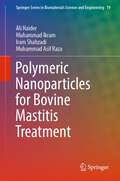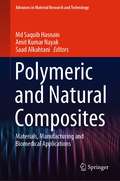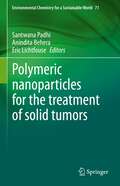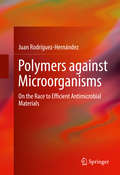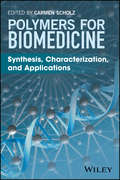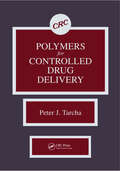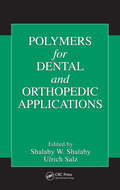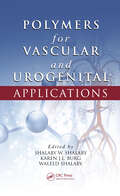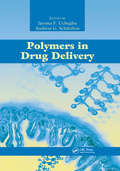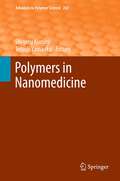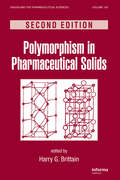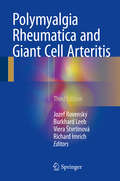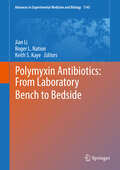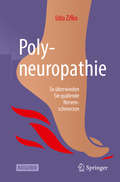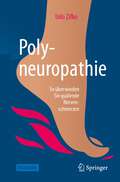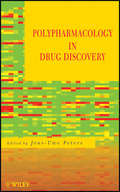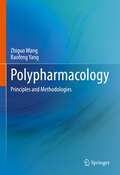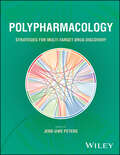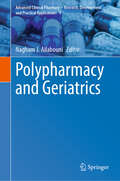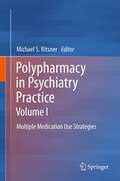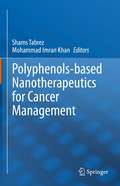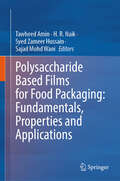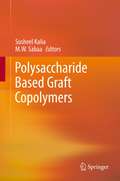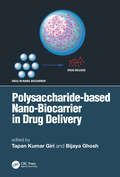- Table View
- List View
Polymeric Nanoparticles for Bovine Mastitis Treatment (Springer Series in Biomaterials Science and Engineering #19)
by Muhammad Ikram Ali Haider Iram Shahzadi Muhammad Asif RazaThis book features an in-depth examination of the ongoing problem of bovine mastitis and the potential solutions offered by polymer nanoparticles. With extensive research and analysis, the book delves into the causes and consequences of bovine mastitis, including the shift in the relevance of various infections and the increasing problem of antibiotic resistance. The authors explore the use of nanoparticles as a potential alternative to traditional antibiotics and the importance of tailoring their characteristics for specific uses. Detailed discussions of the pros and cons of different manufacturing procedures and characterizations of bovine mastitis, drug-resistant bacteria, and resistance development make this monograph an invaluable resource for researchers and experts in the field of veterinary medicine, and an excellent resource for those interested in investigating the viability of nano-materials as future antibiotic alternatives.
Polymeric and Natural Composites: Materials, Manufacturing and Biomedical Applications (Advances in Material Research and Technology)
by Amit Kumar Nayak Md Saquib Hasnain Saad AlkahtaniThis book provides understanding of raw materials, manufacturing and biomedical applications of different polymeric and natural composites such as drug delivery, growth factor delivery, orthopedics, dentistry and wound dressing.
Polymeric nanoparticles for the treatment of solid tumors (Environmental Chemistry for a Sustainable World #71)
by Eric Lichtfouse Santwana Padhi Anindita BeheraThis book focuses on the emerging research in the field of treatment of solid tumors or cancer with new drug delivery systems using nanotechnology. Nanotechnology has given us a good scope for development of new innovative drug delivery strategies to increase the therapeutic efficacy of anticancer drugs with reduced off-target side effects. Cancer is one of the main causes of death worldwide due to the limitations of classical therapies such as low solubility of active drugs, toxic side effects on healthy cells and resistance of tumor cells. These issues are partly solved by the recent development of polymeric nanoparticles, which improve drug absorption and the therapeutic index, while reducing side effects. Drug carriers must be biocompatible, biodegradable and non-immunogenic. Coupled to a ligand that has affinity for that particular cell, polymeric nanoparticles are used to target specifically malignant cells or tissues and, in turn, improve drug stability. This book presents the latest advances in the application of polymeric particles for cancer treatment, with focus on the tumor microenvironment, synthesis, active and passive targeting, patents, targeting over-expressed receptors, tumor-targeting ligands, theranostics, glioblastoma tumors, lung cancer, breast cancer, prostate cancer and pH-responsive nanoparticles
Polymers against Microorganisms
by Juan Rodríguez-HernándezThis book provides an introductory and general overview of advances in polymers towards their employment as antimicrobial materials. The author describes current approaches for avoiding microbial contamination, toward macro-molecular antibiotics, and prevention of antibiotic-resistant bacteria by use of polymers. He establishes the remaining issues and analyzes existing methodologies for treating bacterial infections and for preparing antimicrobial materials.
Polymers for Biomedicine: Synthesis, Characterization, and Applications
by Carmen ScholzHighlighting dynamic developments in polymer synthesis, this book focuses on the chemical techniques to synthesize and characterize biomedically relevant polymers and macromolecules.• Aids researchers developing polymers and materials for biomedical applications• Describes biopolymers from a synthetic perspective, which other similar books do not do• Covers areas that include: cationically-charged macromolecules, pseudo-peptides, polydrugs and prodrugs, controlled radical polymerization, self-assembly, polycondensates, and polymers for surface modification
Polymers for Controlled Drug Delivery
by Peter J. TarchaPolymers for Controlled Drug Delivery addresses the challenges of designing macromolecules that deliver therapeutic agents that function safely and in concert with living organisms. The book primarily discusses classes of polymers and polymeric vehicles, including particulates, such as latexes, coacervates, ion-exchange resins, and liposomes, as well as non-particulate vehicles such as enteric coatings, mediators, and bioadhesives. Other topics discussed include diffusion; biodegradation-controlled delivery; animal model studies for toxicity, metabolism, and elimination testing; and FDA requirements for clinical studies. Drug delivery researchers will find this book to be an invaluable reference tool.
Polymers for Dental and Orthopedic Applications
by Shalaby W. Shalaby Ulrich SalzRecent advances not only in the creation of new polymers but also in their processing and production have ushered in huge strides in a variety of biomedical and clinical areas. Orthopedics and dentistry are two such areas that benefit immensely from developments in polymer science and technology. Polymers for Dental and Orthopedic Applications
Polymers for Vascular and Urogenital Applications (Advances in Polymeric Biomaterials)
by Karen J.L. Burg Shalaby W. Shalaby Waleed ShalabyIn a carefully crafted, multidisciplinary, skillfully focused format, Polymers for Vascular and Urogenital Applications covers attributes of polymers used for vascular, urological, and gynecological materials. It provides a brief analysis of how the use of polymers in vascular and urogenital applications has evolved in the past five decades and out
Polymers in Drug Delivery
by Ijeoma F. Uchegbu Andreas G. SchatzleinTogether, the nano explosion and the genomic revolution are ushering in a new frontier in drug delivery. In recent years we've seen how polymers can play a crucial role in controlling the rate of drug release, enhancing solubility and uptake, and limiting degradation and toxicity. In the very near future, they may well be used to deliver gene thera
Polymers in Nanomedicine
by Tetsuji Yamaoka Shigeru KunugiFunctional Polymer Conjugates for Medicinal Nucleic Acid Delivery, by Ernst Wagner Biodegradable Nanoparticles as Vaccine Adjuvants and Delivery Systems: Regulation of Immune Responses by Nanoparticle-Based Vaccine, by Takami Akagi, Masanori Baba and Mitsuru Akashi Biodegradable Polymeric Assemblies for Biomedical Materials, by Yuichi Ohya, Akihiro Takahashi and Koji Nagahama PEGylation Technology in Nanomedicine, by Yutaka Ikeda and Yukio Nagasaki Cytocompatible Hydrogel Composed of Phospholipid Polymers for Regulation of Cell Functions, by Kazuhiko Ishihara, Yan Xu and Tomohiro Konno Design of Biointerfaces for Regenerative Medicine, by Yusuke Arima, Koichi Kato, Yuji Teramura and Hiroo Iwata Advances in Tissue Engineering Approaches to Treatment of Intervertebral Disc Degeneration: Cells and Polymeric Scaffolds for Nucleus Pulposus Regeneration, by Jeremy J. Mercuri and Dan T. Simionescu Functionalized Biocompatible Nanoparticles for Site-Specific Imaging and Therapeutics, by Ranu K. Dutta, Prashant K. Sharma, Hisatoshi Kobayashi and Avinash C. Pandey
Polymers in Regenerative Medicine
by Manuel Monleon Pradas Maria J. VicentBiomedical applications of Polymers from Scaffolds toNanostructuresThe ability of polymers to span wide ranges of mechanicalproperties and morph into desired shapes makes them useful for avariety of applications, including scaffolds, self-assemblingmaterials, and nanomedicines. With an interdisciplinary list ofsubjects and contributors, this book overviews the biomedicalapplications of polymers and focuses on the aspect of regenerativemedicine. Chapters also cover fundamentals, theories, and tools forscientists to apply polymers in the following ways:Matrix protein interactions with synthetic surfacesMethods and materials for cell scaffoldsComplex cell-materials microenvironments in bioreactorsPolymer therapeutics as nano-sized medicines for tissuerepair Functionalized mesoporous materials for controlleddelivery Nucleic acid delivery nanocarriersConcepts include macro and nano requirements for polymers aswell as future perspectives, trends, and challenges in the field.From self-assembling peptides to self-curing systems, this bookpresents the full therapeutic potential of novel polymeric systemsand topics that are in the leading edge of technology.
Polymorphism in Pharmaceutical Solids (Drugs and the Pharmaceutical Sciences)
by Harry G. BrittainUsing clear and practical examples, Polymorphism of Pharmaceutical Solids, Second Edition presents a comprehensive examination of polymorphic behavior in pharmaceutical development that is ideal for pharmaceutical development scientists and graduate students in pharmaceutical science. This edition focuses on pharmaceutical aspects of polymorphism a
Polymyalgia Rheumatica and Giant Cell Arteritis
by Josef Rovenský Burkhard Leeb Viera Štvrtinová Richard ImrichIn the present monograph, we offer current insights into polymyalgia rheumatica and giant cell arthritis. Both diseases are typical for advanced age, and their incidences increase with aging. Both diseases are a center point of interest not only for rheu- tologists, gerontologists, ophthalmologists or neurologists, but also for general prac- tioners. Early diagnosis and rapid treatment, mainly with glucocorticoids can save one of the most precious senses-vision. Damage to other organs (heart, aorta, co- nary arteries, liver, lungs, kidneys), which are supplied by the arteries affected by ischemic syndrome in the setting of giant cell arthritis, has serious consequences as well. Late diagnosis of giant cell arthritis can have fatal consequences for affected patients. It is a matter of fact that the human population is aging. Therefore, more attention has to be paid not only to diagnosis, clinical course and treatment of rheumatic d- eases in elderly, but also to their genetic, immunologic, endocrinologic, chronobiologic mechanisms, and state-of-the-art diagnostic modalities. I am convinced that the int- disciplinary research of the diseases will allow us to diagnose and treat the rheumatic diseases even faster and more effectively in the future.
Polymyxin Antibiotics: From Laboratory Bench to Bedside (Advances in Experimental Medicine and Biology #1145)
by Jian Li Keith S. Kaye Roger L. NationThis volume is the first-ever complete treatise on polymyxins and presents the most comprehensive and up-to-date reviews of all major research and clinical topics from chemistry, microbiology, pharmacology, clinical use, to drug discovery. All chapters were written by internationally leading researchers and clinicians in the field.It is our wish that readers discover the importance of polymyxin structure in relation to the mechanisms of activity, resistance and toxicity. We emphasized that reliable analytic methods for polymyxins are critical when investigating their pharmacokinetics (PK) and pharmacodynamics (PD). The complicated dose definitions and different pharmacopoeial standards have already compromised the safe use of polymyxins in patients. Therefore, informed by the latest pharmacological information, scientifically-based dosing recommendations have been proposed for intravenous polymyxins. Considering the PK/PD limitations and potential development of resistance, polymyxin combinations are encouraged; however, the current literature has not shown definite microbiological benefits, possibly because most clinical studies to date overlooked key PK/PD principles. Nephrotoxicity is the major dose-limiting factor and it is imperative to elucidate the mechanisms and develop novel approaches to minimize polymyxin-associated toxicities. In addition, the anti-endotoxin effect of polymyxins supports their clinical use to treat Gram-negative sepsis. Fortunately, the discovery of new-generation polymyxins with wider therapeutic windows has benefited from the latest achievements in polymyxin research. This book provides extensive pharmacological information on polymyxins to infectious diseases clinicians, pharmacists, clinical microbiologists, antimicrobial pharmacologists, and pharmaceutical scientists, and is an essential read for those who aim to develop novel polymyxins and improve their clinical use as a last-line defense against Gram-negative ‘superbugs’.
Polyneuropathie: So überwinden Sie quälende Nervenschmerzen
by Udo ZifkoDer Ratgeber erklärt in einer zweiten aktualisierten Auflage einfach und verständlich das Krankheitsbild, deutet mögliche Frühwarnsignale oder Symptome anhand von Beispielen, und zeigt den Weg zur gesicherten Diagnose mit Vorstellung der unterschiedlichen medizinischen Verfahren. Zudem werden die therapeutischen Möglichkeiten samt Selbsthilfe der Patienten vorgestellt. Kribbeln und Stechen, brennende Schmerzen, aber auch Taubheit in bestimmten Körperteilen können erste Anzeichen für eine Polyneuropathie sein. Gerade in den letzten Jahren konnten in der Polyneuropathie-Forschung große Fortschritte erzielt werden, die in diesem Buch hautnah weitergegeben werden. Vorgestellt werden nicht nur ein breites Spektrum an erfolgsversprechenden Behandlungen, sondern auch eine Reihe von Selbsthilfemaßnahmen. Ergänzt wird das Buch mit praxisnahen Fallbeispielen, einem umfangreichen Serviceteil mit hilfreichen Adressen sowie Antworten auf häufige Patientenfragen. Die Neuauflage wurde erweitert mit aktuellen Informationen zu den Cannabinoiden, zum Schmerzpflaster sowie zu komplementären therapeutischen Methoden und Ernährungstipps. Das Buch richtet sich in erster Linie an alle Betroffene und deren Angehörigen, bietet aber auch für Allgemeinmediziner oder Vertreter anderer Gesundheitsberufen einen guten Überblick zum Krankheitsbild und den therapeutischen Ansätzen.
Polyneuropathie: So überwinden Sie quälende Nervenschmerzen
by Udo ZifkoKribbeln und Stechen, brennende Schmerzen, aber auch Taubheit in bestimmten Körperteilen können erste Anzeichen für eine Polyneuropathie sein. Der Ratgeber erklärt in einer dritten aktualisierten Auflage einfach und verständlich das Krankheitsbild, deutet mögliche Frühwarnsignale oder Symptome anhand von Beispielen, und zeigt den Weg zur gesicherten Diagnose mit Vorstellung der unterschiedlichen medizinischen Verfahren. Zudem werden die therapeutischen Möglichkeiten samt Selbsthilfe der Patienten beschrieben. Vorgestellt werden nicht nur ein breites Spektrum an erfolgsversprechenden Behandlungen, sondern auch eine Reihe von Selbsthilfemaßnahmen. Ergänzt wird das Buch mit praxisnahen Fallbeispielen, einem umfangreichen Serviceteil mit hilfreichen Adressen sowie Antworten auf häufige Patientenfragen. Die Neuauflage wurde erweitert mit aktuellen Informationen zu Covid-19, Long Covid und hilfreichen Bewegungsübungen. Das Buch richtet sich in erster Linie an alle Betroffene und deren Angehörigen, bietet aber auch für Allgemeinmediziner oder Vertreter anderer Gesundheitsberufen einen guten Überblick zum Krankheitsbild und den therapeutischen Ansätzen.
Polypharmacology in Drug Discovery
by Jens-Uwe PetersAn essential outline of the main facets of polypharmacology in drug discovery researchExtending drug discovery opportunities beyond the "one drug, one target" philosophy, a polypharmacological approach to the treatment of complex diseases is emerging as a hot topic in both industry and academic research. Polypharmacology in Drug Discovery presents an overview of the various facets of polypharmacology and how it can be applied as an innovative concept for developing medicines for treating bacterial infections, epilepsy, cancer, psychiatric disorders, and more. Filled with a collection of instructive case studies that reinforce the material and illuminate the subject, this practical guide:Covers the two-sided nature of polypharmacology-its contribution to adverse drug reactions and its benefit in certain therapeutic drug classesAddresses the important topic of polypharmacology in drug discovery, a subject that has not been thoroughly covered outside of scattered journal articlesOverviews state-of-the-art approaches and developments to help readers understand concepts and issues related to polypharmacologyFosters interdisciplinary drug discovery research by embracing computational, synthetic, in vitro and in vivo pharmacological and clinical aspects of polypharmacologyA clear road map for helping readers successfully navigate around the problems involved with promiscuous ligands and targets, Polypharmacology in Drug Discovery provides real examples, in-depth explanations and discussions, and detailed reviews and opinions to spark inspiration for new drug discoveryprojects.
Polypharmacology: Principles and Methodologies
by Zhiguo Wang Baofeng YangThere is a growing interest in unmet needs for the development of a new discipline in drug discovery and in university education on polypharmacology. However, there has not been a book with the comprehensive compilation of basic knowledge and advanced methodology that is needed. This book aims to meet the needs making Polypharmacology a new sub-discipline of Pharmacology, not only being a hot area of pharmacological research and education but also a new paradigm for drug discovery. It contains the contents covering the entire scope of Polypharmacology including systemic in-depth exposition of basic knowledge, novel concepts, innovative technologies, and translational and clinical applications by showcasing state-of-the-art strategies and step-by-step instructions of cutting-edge methods. The contents of this book targets broad readerships including scientists in pharmacology research and drug development, and university teachers and graduates in medical school or school of pharmacy.
Polypharmacology: Strategies for Multi-Target Drug Discovery
by Jens-Uwe PetersPractical guide to navigate problems involved with promiscuous ligands and multi-target drug discovery, supported by case studies and real examples Polypharmacology covers the two-sided nature of polypharmacology: its relevance for adverse drug effects, as well as its benefit for certain therapeutic drug classes in effectively treating complex diseases like psychosis and cancer. The book provides practical guidelines and advice to help readers design drugs that have multiple targets while minimizing unwanted off-target effects, discusses important disease areas like viral infection, diabetes, and obesity that have advanced significantly in the last decade, and guides researchers in neighboring areas to polypharmacology. The book is divided into four parts. Part A covers the link between off-targets and adverse drug reactions, how to screen for off-target activity, and how to recognize and optimize compounds with a potential for off-target activity. Part B discusses disease areas which benefit from polypharmacological approaches. Part C highlights important approaches, such as compound design, data mining with web-based tools, and multi-target peptides. Part D provides case study coverage on topics like CDK4/6 inhibitors for cancer treatment, the potential of multi-target ligands for COVID, and protein degraders and PROTACs. Sample topics discussed in Polypharmacology include: Molecular properties and structural motifs in pharmacological promiscuity, covering lipophilicity, molecular weight, and other parametersKinase liabilities in early drug discovery, covering core kinases driving the cell division cycle and consequences of interference, and cell cycle checkpoints controlling cell divisionTreatment of major depressive disorder, covering tricyclic antidepressants, monoamine oxidase inhibitors, and selective serotonin and norepinephrine reuptake inhibitorsTrends in the field, such as novel antipsychotics, standardization of screening tools, and the SmartCube System®, as well as lessons from history Delivering the latest research developments in the field, Polypharmacology is an essential reference on the subject for medicinal chemists, pharmacologists, biochemists, computational chemists, and biologists, as well as pharmaceutical professionals involved in drug discovery programs.
Polypharmacy and Geriatrics (Advanced Clinical Pharmacy - Research, Development and Practical Applications #3)
by Nagham J. AilabouniThis book aims to collate contemporary, evidence-based literature regarding the safe and quality use of medicines in older people. It considers the role of engaging consumers in all parts of clinical care and throughout all stages of research to create real-world impact. It includes practical clinical implications from the perspectives of healthcare professionals including physicians, nurses, and pharmacists to improve the use of medicines in older people and reduce their risk of medicine-related harm.
Polypharmacy in Psychiatry Practice, Volume II
by Michael S RitsnerAlthough monotherapy is generally recommended as the treatment of choice, treatment resistance of patients with psychosis, cognitive, mood and anxiety disorders represents a significant clinical problem. In this context, augmentation and combination strategies are commonly employed to address this problem. Although multiple medication use common in psychiatric practice, reasons, efficacy and safety for polypharmacy, and augmentative strategies have remained unclear. It remains unclear if there is an evidence base to support polypharmacy. Furthermore, excessive and inappropriate use of psychotropic medications has been recognized as a public health problem. This volume is the first comprehensive, clinically oriented, reference on the multiple medication use to treat psychotic, cognitive, mood and anxiety disorders.
Polyphenols-based Nanotherapeutics for Cancer Management
by Shams Tabrez Mohammad Imran KhanThis book reviews the applications of polyphenols in cancer treatment. The initial chapter of the book classifies different polyphenols and discusses their biological and chemical properties. The subsequent chapters then explore the diverse role of polyphenols in modulating signal transduction pathways in cancer including, cellular proliferation, differentiation, apoptosis, inflammation, angiogenesis, and metastasis. This book highlights the usefulness of polyphenol enriched seafood in modulating the anti-tumor and anti-inflammatory cytokine IFN-γ. The book also presents nanoformulation of polyphenol as a promising strategy for their enhanced bioavailability and targeted delivery. Lastly, the book examines the toxicity and safety evaluations of polyphenols as anticancer agents.
Polysaccharide Based Films for Food Packaging: Fundamentals, Properties and Applications
by Syed Zameer Hussain Tawheed Amin Sajad Mohd Wani H. R. NaikThis book offers an extensive overview of the current and future potential of polysaccharides-based films, providing in-depth coverage of the fundamentals and basics of polysaccharide-based films.Aimed at students, scholars, scientists, and food packaging professionals, this book delves into the properties and applications of polysaccharide-based edible films in the food packaging industry. It provides insights and pathways for widening the applications of polysaccharide-based films to maximize their benefits in various industries and research institutes worldwide. With a wealth of scientific knowledge presented in an organized manner, this book serves as a valuable reference for researchers and professionals in food and pharmaceutical industries, as well as those in research and development (R&D) institutes.
Polysaccharide Based Graft Copolymers
by Susheel Kalia M. W. SabaaRenowned experts give all essential aspects of the techniques and applications of graft copolymers based on polysaccharides. Polysaccharides are the most abundant natural organic materials and polysaccharide based graft copolymers are of great importance and widely used in various fields. Natural polysaccharides have recently received more attention due to their advantages over synthetic polymers by being non-toxic, biodegradable and available at low cost. Modification of polysaccharides through graft copolymerization improves the properties of polysaccharides. Grafting is known to improve the characteristic properties of the backbones. Such properties include water repellency, thermal stability, flame resistance, dye-ability and resistance towards acid-base attack and abrasion. Polysaccharides and their graft copolymers find extensive applications in diversified fields. Applications of modified polysaccharides include drug delivery devices, controlled release of fungicides, selective water absorption from oil-water emulsions, purification of water etc.
Polysaccharide based Nano-Biocarrier in Drug Delivery
by Tapan Kumar Giri Bijaya GhoshThis book discusses various fundamental aspects of polysaccharide based nano-biocarrier drug delivery systems and its application in the delivery of small molecules, proteins, peptides, oligonucleotides and genes. It also discusses advances in drug delivery systems in treatment of cancer, cardiovascular, pulmonary, and infectious diseases.
